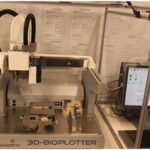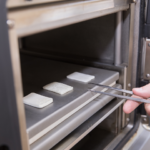

Researchers from the Aristotle University of Thessaloniki in Greece have developed a new method for patient-specific medical treatment, outlined in the recently published ‘Development of Bio-Active Patches Based on Pectin for the Treatment of Ulcers and Wounds Using 3D-Bioprinting Technology.’
Using biodegradable 3D printable inks, the Greek scientists have created transparent films that can serve as free-standing patches with both antimicrobial and wound-healing properties, via chitosan and cyclodextrin/propolis extract inclusion complexes (CCP).
The patches were bioprinted and then evaluated by the research team for biocompatibility, antimicrobial levels, and wound-healing capabilities in vitro.
The study also included:
- Ex vivo skin adhesion measurements
- Relative surface hydrophobicity
- Opacity measurement
- Mechanical properties
- Visualization
- Spectroscopic techniques
The point of the study was to create a natural, nontoxic wound-dressing system with a suitable moisture environment, as well as properties eliminating infection. Alternative materials like pectin and honey have been known to assist in wound treatment, allowing for moisture and antibacterial qualities.
“Another natural material used in this study is propolis. More than 300 different compounds have been identified in propolis, including aliphatic acids, esters, aromatic acids, fatty acids, carbohydrates, aldehydes, amino acids, ketones, chalcones, dihydrochalcones, terpenoids, vitamins, and inorganic substances, with flavonoids being the most widely studied,” explained the researchers. “The positive therapeutic effects of propolis are well established and mostly attributed to the antioxidant activity of polyphenols.
“It is also well‐documented that propolis contains active compounds, like caffeic acid, caffeic phenyl ester, artepillin C, quercetin, resveratrol, galangin, and genistein, that promote cell proliferation. Propolis, in general, is studied for its antiseptic, antibacterial, antimycotic, astringent, spasmolytic, anti‐inflammatory, anesthetic, antioxidant, antifungal, antiulcer, anticancer, and immunomodulatory effects.”

The researchers suggest that a combination of all three materials could be used for wound-healing patches, with 3D printing used for the development of patient-specific treatment; however, in this study, their bioinks consisted of high methoxylated pectin with Manuka honey, while inclusion complex received an addition of ethanolic extract of propolis. The complexes were then combined also with chitosan, therefore exploiting ionic bonds created between the materials.
3D printed patches were compared after drying, examining theoretical and experimental dimensions. The patches were dried until reaching a constant weight of 75 °C. Dimensions were then compared to a 2x2cm control frame. In examining the pectin films, the researchers found that there was ‘insufficient antimicrobial activity.’ This was not a surprise, however, as the volume of honey added to the bacteria was highly diluted. With CCP incorporation of up to 10% w/w CCP, the researchers noted an ‘intense increase’ of antimicrobial activity—up to 95 percent more.
The study did show that 3D printed pectin patches possessed ‘strong wound-healing properties in vitro, improved further with CCP, up to 5% w/w.
“In all cases, elongated cell formations with multiple infusions were observed, typical of migrating cells, along with changes in their spatial conformation. For CCP concentrations higher than 10% w/w, the presence of an insoluble film material exhibited an inhibitory effect on cell migration, despite the migration of individual cells towards the empty scratched area.”
“The evaluation methodology followed in the current study rendered the inks suitable for 3D printing applications. Free‐standing transparent films that disintegrate upon contact with aqueous media were developed via 3D bioprinting. The antimicrobial and wound‐healing activities of the fabricated dressings were investigated and effectually enhanced by the incorporation of particles comprised of chitosan and cyclodextrin inclusion complexes with propolis extract,” concluded the researchers.
Patient-specific treatments are the wave of the future, already offering great benefits to patients around the world due to the use of 3D printed models for diagnostics, treatment, training and more—as well as medical devices like implants and prosthetics.
Bioink and bioprinting offer enormous promise for tissue regeneration and engineering. What do you think of this news? Let us know your thoughts; join the discussion of this and other 3D printing topics at 3DPrintBoard.com.
[Source / Images: ‘Development of Bio-Active Patches Based on Pectin for the Treatment of Ulcers and Wounds Using 3D-Bioprinting Technology’]
If you're looking for affordable 3D visualization services in the USA, our platform provides an ideal solution for all your architectural and real estate needs. Through our service, you can access high-quality 3D renderings at competitive prices without compromising on quality. Whether you need interior visualizations, exterior renderings, or architectural animations, our team ensures that you get professional results that fit within your budget. With our support, you can make your projects visually stunning while saving on costs, all with a quick and straightforward process.
Through our site, you can easily order affordable 3D visualizations for your projects, whether for a residential property, commercial development, or architectural design. We understand the importance of staying within budget, and that's why we offer tailored solutions to ensure you get the best value for your investment. Our experts work efficiently to provide you with realistic, photorealistic 3D images that will elevate your presentations and attract clients, making your property stand out in the market.






